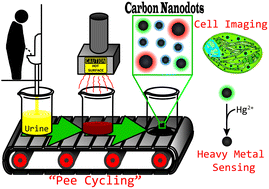Pee-dots: biocompatible fluorescent carbon dots derived from the upcycling of urine†
Abstract
We have demonstrated an easy, economic, one-step synthetic route to water-soluble fluorescent carbon dots derived from the thermal upcycling of urine. These “pee-dots” (PDs), which primarily comprise hydrophile-decorated amorphous carbon, exhibit bright, stable, excitation wavelength dependent fluorescence in aqueous solution and are shown to be useful nanoscale labels in cell imaging applications. Cytotoxicity studies demonstrate that these PDs are benign toward model cell lines, even at concentrations as high as 500 μg mL−1. Notably, this approach converts an otherwise useless, negatively-valued byproduct of human life into a value-added nanoscale product while simultaneously pasteurizing the waste stream. The reported PDs proved to be effective nanoprobes for the fluorescence-based detection of heavy metal ions of environmental concern, particularly Cu2+ and Hg2+ ions which were found to be strong quenchers of their fluorescence. Interestingly, the optical properties and nanoscale dimensions of the PDs are a direct reflection of the diet (e.g., vitamin C or asparagus (sulfur) fortified) followed by the urine donor.


 Please wait while we load your content...
Please wait while we load your content...